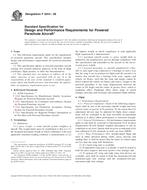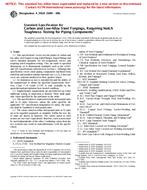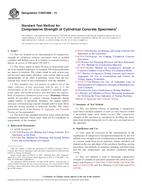1.1 This specification covers both developing property designations and specifications for thermoplastic compositions consisting of vinylidene fluoride (VDF) polymers modified with other fluoromonomers and property-enhancing additives. The other fluoromonomers include one or more of the following: hexafluoropropylene (HFP), tetrafluoroethylene (TFE), and chlorotrifluoroethylene (CTFE). The additives are those that improve its flame resistance, processing, or physical properties. However, these additives are not normally considered to be reinforcing. This specification covers thermoplastic compositions supplied in pellet or powder forms.
1.2 A designation or specification applies only to the virgin polymers prepared from vinylidene fluoride (>50 weight %) with one or more of the following comonomers: hexafluoropropylene, tetrafluoroethylene, and chlorotrifluoroethylene. These polymers may contain additives to enhance certain properties.
1.3 This system constitutes a line callout as a means of designating and specifying properties of VDF-based copolymers. At least four of the designated properties are used to define a polymer’s specification. Specification criteria from international documents can be used if their criteria match designation properties currently used by this specification. This specification is not intended for the selection of materials.
1.4 The manufacturer of the virgin resin shall establish the designation of a resin based on the property value criteria in this specification.
1.5 The minimum specification properties are established by this specification. Additional specification properties, based on the designation properties cited, can be established by the resin supplier and customer.
1.6 The values stated in SI units are to be regarded as standard and the practices of IEEE/ASTM SI-10 incorporated herein, except where common usage or test method specify common units acceptable within IEEE/ASTM SI-10.
1.7 The property tests are intended to provide information for specifications of modified VDF-copolymer compositions. It is not the purpose of this specification to provide engineering data for design purposes.
Note 1 – Although the values listed in Table 1, Table 2, Table 3, Table 4, Table 5 are necessary to include the range of properties available in existing materials, they should not be interpreted as implying that every possible combination of the properties exists or can be obtained. It is possible for a user or designer, using , to call out property relationships that are physically impossible to occur in a copolymer made using current technology.
Note 2 – Many of these polymers exhibit polymorphism. The type and extent of crystalline structure can vary with the thermomechanical history of the sample. Specimens prepared by different techniques could have properties that may vary.
1.8 Test methods used in this specification may involve the incidental production of hazardous materials. Modified VDF polymer fluoroplastics melt between 90 and 182°C (194 and 359°F) and are thermally stable up to about 350°C (662°F), or somewhat higher, depending on the composition. Evolution of corrosive, colorless, and toxic hydrogen fluoride can occur under certain conditions.
1.9 This standard does not purport to address all of the safety concerns, if any, associated with its use. It is the responsibility of the user of this standard to establish appropriate safety and health practices and determine the applicability of regulatory limitations prior to use. See Warning in 1.8 and Section 10 for specific hazards statements.
Note 3 – Most of the technical content of this specification is included as part of ISO 12086/1, 2. These standards have been approved for publication and are in the final editing process. Many designations from the ISO standards will be similar to those from this ASTM specification.
Product Details
- Published:
- 11/01/2003
- Number of Pages:
- 12
- File Size:
- 1 file , 110 KB


